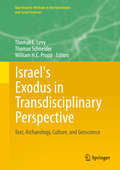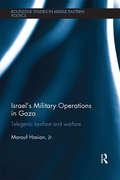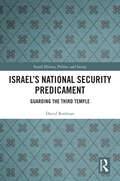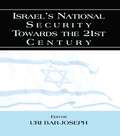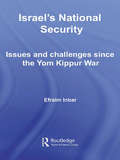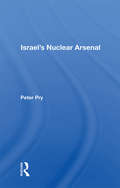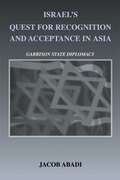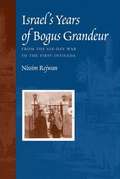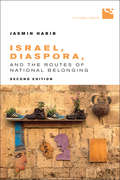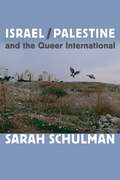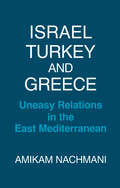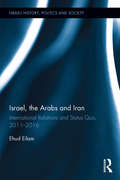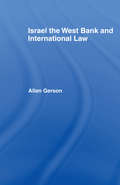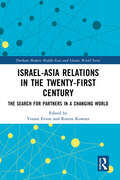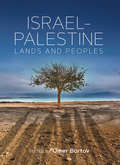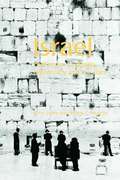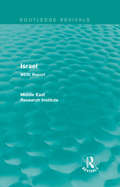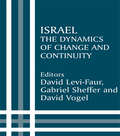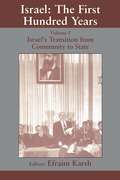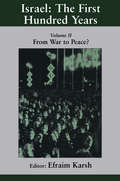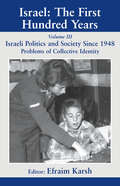- Table View
- List View
Israel's Exodus in Transdisciplinary Perspective
by Thomas Schneider Thomas E. Levy William H.C. ProppThe Bible's grand narrative about Israel's Exodus from Egypt is central to Biblical religion, Jewish, Christian, and Muslim identity and the formation of the academic disciplines studying the ancient Near East. It has also been a pervasive theme in artistic and popular imagination Israel's Exodus in Transdisciplinary Perspective is a pioneering work surveying this tradition in unprecedented breadth, combining archaeological discovery, quantitative methodology and close literary reading. Archaeologists, Egyptologists, Biblical Scholars, Computer Scientists, Geoscientists and other experts contribute their diverse approaches in a novel, transdisciplinary consideration of ancient topography, Egyptian and Near Eastern parallels to the Exodus story, the historicity of the Exodus, the interface of the Exodus question with archaeological fieldwork on emergent Israel, the formation of biblical literature, and the cultural memory of the Exodus in ancient Israel and beyond. This edited volume contains research presented at the groundbreaking symposium "Out of Egypt: Israel's Exodus Between Text and Memory, History and Imagination" held in 2013 at the Qualcomm Institute of the University of California, San Diego. The combination of 44 contributions by an international group of scholars from diverse disciplines makes this the first such transdisciplinary study of ancient text and history. In the original conference and with this new volume, revolutionary media, such as a 3D immersive virtual reality environment, impart innovative, Exodus-based research to a wider audience. Out of archaeology, ancient texts, science and technology emerge an up-to-date picture of the Exodus for the 21st Century and a new standard for collaborative research.
Israel's Military Operations in Gaza: Telegenic Lawfare and Warfare (Routledge Studies in Middle Eastern Politics)
by Marouf Hasian JrCivilians in Gaza and Israel are caught up in complex, violent situations that have overstepped conventional battle lines. Both sides of the conflict have found ways to legitimate the use of violence, and continually swap accusations of violations of domestic and international humanitarian laws. Israel’s Military Operations in Gaza provides an ideological critique of the legal, military, and social media texts that have been used to legitimate historical incursions into the Gaza, with special focus on Operation Protective Edge. It argues that both the Palestinians and the Israelis have deployed various forms of ‘telegenic’ warfare. They have each used argumentative rhetorics based on competing interpretations of events, and are locked in a battle to convince international audiences and domestic constituencies of the righteousness of their causes. This critical genealogical study analyses a range of texts and images, from selfies circulated near the Gaza border to judicial opinions produced by the High Court of Israel. With its multidisciplinary approach and original analysis of the Israel/Gaza situation, this book will be of interest to students and scholars of Middle East studies and the Arab-Israeli conflict, as well as security studies and communication studies.
Israel's National Security Law: Political Dynamics and Historical Development (Israeli History, Politics and Society)
by Stuart Cohen Amichai CohenTerror attacks on western civilian targets have stimulated interest in the dilemmas faced by liberal societies when combating threats to national security. Combining the perspectives of political science and law, this book addresses that discourse, asking how democracies seek to harmonize the protection of individual liberties with the defence of state interests. The book focuses on the experience of Israel, a country whose commitment to democratic values has continuously been challenged by multiple threats to national survival. It examines the legal, legislative and institutional methods employed to resolve the dilemmas generated by that situation, and thus provides a unique interpretation of Israeli national security behaviour. Policy-making and policy-implementation in this sphere, it shows, have reflected not just external constraints but also shifts in the domestic balance of power between the executive, the legislature and the judiciary. The book concludes with an agenda of the measures that each branch of government needs to implement in order to repair the flaws that have developed in this system over time. Based on a close reading of legislative and court readings, the book proposes a new taxonomy for the analysis of national security legal frameworks, both in Israel and elsewhere in the democratic world. As such it will be of great interest to students and scholars of political science, national security law, Israeli history and civil-military relations.
Israel's National Security Predicament: Guarding the Third Temple (Israeli History, Politics and Society)
by David RodmanThis book provides a ground-breaking assessment of the Israeli national security experience from the establishment of the country through to the present day. Seventy-five years after its establishment, the State of Israel continues to face an acute national security predicament as a result of the still unresolved Arab–Israeli conflict. This monograph offers a new framework for analyzing this experience, first exploring the crucial events of the past and present that define it, including interstate wars, asymmetrical wars, low-intensity conflicts, and developments in weapons of mass destruction. The book then probes how Israel’s evolving national security doctrine has addressed these various challenges over the years, highlighting the roles of a number of variables: deterrence, warning, and decision; strategic depth and defensible borders; the quality and quantity of fighting men and machines; intelligence; self-reliance in military matters; foreign policy; and the influence of ethnic demography, societal resilience, economic prosperity, and water security. Written in accessible, non-technical language, the book will appeal to general readers seeking an introduction to Israeli security, as well as to specialists and researchers in various fields, including Israeli history, Middle Eastern politics, and security studies.
Israel's National Security Towards the 21st Century
by Uri Bar-JosephThis volumes discusses three principal issues: the Israeli army and the Revolution of Military Affairs (RMA); Israel's present and future answers to the threays of weapons of mass destruction (WMD); and the impact of societal, political, and technological changes on Israel's future war objectives.
Israel's National Security: Issues and Challenges Since the Yom Kippur War (Israeli History, Politics and Society)
by Efraim InbarThis volume presents a comprehensive analysis of Israel's security challenges since the 1973 October War. Efraim Inbar takes the reader on a historical journey through Israel's relations in the Middle East that begins with an analysis of Israel's strategic thinking after 1973 and ends with an important look at the recent Second Lebanese War and the Iranian nuclear challenge. Israel's National Security delves not only into Israel's responses, but also its relationships in the international community, providing a complete picture of how Israel's strategic environment has evolved over time. Relevant to today's current political atmosphere, the volume dissects the influences of the growing appeal of Islamic extremism on the peace process, Israel strategic partnerships with India and Turkey, and Israel's relations with the Palestinians.
Israel's Nuclear Arsenal
by Peter PryIsrael's Nuclear Arsenal is a full inquiry into the likely size and sophistication of the Israeli nuclear weapons program. Among the key questions it addresses are: Did other nations—the United States, France, or West Germany, for example—assist Israel in developing its nuclear weapons capacity? What is the nature of Israel's industrial nuclear inf
Israel's Quest for Recognition and Acceptance in Asia: Garrison State Diplomacy (Israeli History, Politics and Society #No. 34)
by Jacob AbadiThis title represents a comprehensive study of Israel's attempts to build diplomatic relations with countries on the Asian continent. The author argues that, despite the persistence of the Arab Israeli conflict, the Israeli Foreign Ministry was remarkably successful in gaining recognition in most Asian countries. He provides an overview of Israel's relations with Asian countries from 1948 until the present, and analyses the political, social and economic factors in each country and the role that each played in the process of rapprochement with Israel. He explores the reasons for Israel's successes as well as its failures, and analyses the flaws in Israeli diplomacy.
Israel's Security Networks
by Gabriel Sheffer Oren BarakSince the establishment of the State of Israel in 1948, and particularly after the Israeli-Arab War of 1967, a highly informal but simultaneously potent security network has influenced Israel's domestic sphere. Composed of acting and former security personnel and their partners in the state's various civilian spheres, this security network has affected Israeli culture, politics, society, economy, public discourse and foreign relations. This book discusses this major sociopolitical phenomenon and its effects in a comparative and theoretical perspective. First, it defines Israel's security network in a broad theoretical and comparative perspective. Second, it explains how Israel's security network emerged and acquired a hegemonic position in the area of national security and foreign policy. Third, it describes the security network and identifies its members. Fourth, it discusses and explains the multitude of roles that Israel's security network has come to play both domestically and externally. Fifth, it discusses similar phenomena in other relevant cases. Finally, it presents general analytical and theoretical conclusions.
Israel's Years of Bogus Grandeur: From the Six-Day War to the First Intifada
by Nissim Rejwan foreword by Nancy E. BergOn the eve of the Six-Day War in 1967, Israel was nineteen years old and as much an adolescent as the average nineteen-year-old person. Issues of identity and transition were the talk among Israeli intellectuals, including the writer Nissim Rejwan. Was Israel a Jewish state or a democratic state? And, most frustratingly, who was a Jew? As Nancy Berg's foreword makes clear, these issues became more critical and complex in the two decades after the war as Israel matured into a regional power. Rejwan, an Iraqi-born Jew whose own fate was tied to the answers, addresses the questions of those days in his letters, essays, and remembrances collected in Israel's Years of Bogus Grandeur. Israel's overwhelming victory in 1967 brought control of the former Palestinian territories; at the same time, Oriental Jews (i. e. , those not from Europe) became a majority in the Israeli population. The nation, already surrounded by hostile, recently humiliated Arab neighbors, now had an Arab majority (Jewish, Muslim, Druze, and Christian) within its borders--yet European Jews continued to run the country as their own. Rejwan wrote tirelessly about the second-class status of Arab Israelis (and especially of Arab Jews), encouraging a more inclusive attitude that might eventually help heal the wounds left by the Six-Day War. His studies in sociology at Tel Aviv University informed his work. For his cause, Rejwan lost his job and many of his friends but never his pen. Through Munich, Entebbe, political scandals, economic crises, and the beginning of the Intifada, Rejwan narrates Israel's growing pains with feisty wit and unwavering honesty.
Israel, Diaspora, and the Routes of National Belonging, Second Edition (Cultural Spaces)
by Jasmin HabibOver the course of four years, Jasmin Habib was a participant observer on tours of Israel organized for diaspora Jews as well as at North American community events focusing on Israel and Israel-diaspora relations. In this book, she argues that much of the existing literature about North American Jews and their relationship to Israel ignores their reactions to official narratives and perpetuates an "official silence" surrounding the destructive aspects of nationalist sentiments. The second edition of Israel, Diaspora, and the Routes of National Belonging includes a new introduction by the author that builds on her groundbreaking research and reflects on the changes to scholarship since the book’s publication in 2004. Additionally, by exploring the dramatic changes to the region’s politics, Habib ensures that the startlingly honest, theoretically rich, and detailed analysis of her original work continues to be of relevance over a decade later.
Israel, Palestine and the Queer International
by Sarah SchulmanIn this chronicle of political awakening and queer solidarity, the activist and novelist Sarah Schulman describes her dawning consciousness of the Palestinian liberation struggle. Invited to Israel to give the keynote address at an LGBT studies conference at Tel Aviv University, Schulman declines, joining other artists and academics honoring the Palestinian call for an academic and cultural boycott of Israel. Anti-occupation activists in the United States, Canada, Israel, and Palestine come together to help organize an alternative solidarity visit for the American activist. Schulman takes us to an anarchist, vegan café in Tel Aviv, where she meets anti-occupation queer Israelis, and through border checkpoints into the West Bank, where queer Palestinian activists welcome her into their spaces for conversations that will change the course of her life. She describes the dusty roads through the West Bank, where Palestinians are cut off from water and subjected to endless restrictions while Israeli settler neighborhoods have full freedoms and resources.
Israel, Turkey and Greece: Uneasy Relations in the East Mediterranean
by Amikam NachmaniFirst Published in 1987. Routledge is an imprint of Taylor & Francis, an informa company.
Israel, a Personal History: A Personal History
by Göran RosenbergCombining poignant memoir and historical research, a son of Holocaust survivors grapples with the dream of Zionism and its consequences.Israel: A Personal History takes off where Göran Rosenberg&’s internationally acclaimed and award-winning childhood memoir, A Brief Stop on the Road from Auschwitz, ends. After his father&’s suicide in 1960 in a small industrial town in Sweden, the remainder of the family, a single mother with two children, emigrates to Israel. At first fully absorbed into the world of pioneer Zionism, enchanted by its visions, formed by its ethos, Rosenberg would eventually embark on a journey of discovery among betrayed ideals, buried stories, false promises, and erased villages.The result is a deeply personal, painstakingly researched, and beautifully written exploration of the contradictory visions that went into the Zionist project, as well as of the ethnic violence, oppression, discrimination, and dispossession caused by its realization. This book is both an exciting history of ideas and the political autobiography of a Jewish European intellectual, a child of dreams and disillusionments, an astute observer of our times.
Israel, the Arabs and Iran: International Relations and Status Quo, 2011-2016 (Israeli History, Politics and Society)
by Ehud EilamIsrael borders four states – Syria, Egypt, Jordan and Lebanon, and two entities – the Palestinian authority in the West Bank and Hamas in the Gaza stip. In recent years, despite incidents on the border with Syria and Egypt, the basic strategic status quo with these countries has not changed, and the overall balance of power between Israel and the Arabs has been maintained. Due to its military might, none of Israel's Arab neighbours are able to defeat it. Israel, however, for political, economic and military reasons, avoids enforcing its will and interfering in internal Arab matters and has successfully managed to stay out of the Arab turmoil. Israel, the Arabs and Iran gives a detailed overview of the various national security challenges that Israel has faced since 2011. It explains the key considerations and constraints Israel has had to deal with on several fronts, from its northern border with Lebanon to its southern border with Egypt. The book provides the reader with a deep understanding of why and how Israel has struggled to keep the status quo, whilst a large part of the Middle East remains in turmoil. The book is aimed at anyone studying Israel, its Foreign Policy, Middle Eastern Politics and International Relations. It will also appeal to government officials, military officers and anyone working or interested in national security issues concerning the Middle East and particularly Israel.
Israel, the West Bank and International Law
by Allan GersonSynthesizing primary and technical data, this book focuses on the legal and political aspects of Israeli administration in the West Bank and the international attempt to resolve the dispute over the territories. The author assesses the present situation and provides guidelines for future action.
Israel-Asia Relations in the Twenty-First Century: The Search for Partners in a Changing World (Durham Modern Middle East and Islamic World Series)
by Rotem Kowner Yoram EvronThis book examines Israel's growing interaction with Asia's sub-regions and countries since the 1990s. It shows how these interactions have increased in recent years, both at government level and for companies, entrepreneurs, academic institutions, religious groups, tourists, and NGOs. Likewise, it discusses the evolving shared interests between Israel and Asian states and demonstrates how Asian countries adopted sophisticated policies that allowed them to get closer to Israel without compromising their traditional support of the pro-Palestinian position. It also explores how Israel differentiates between different regions, circles of importance, and countries in Asia rather than sees Asia as a monolithic whole. This groundbreaking book concludes by assessing the overall state of relations at present and likely future developments.
Israel-Palestine: Lands and Peoples
by Omer BartovThe conflict between Israel and Palestine has raised a plethora of unanswered questions, generated seemingly irreconcilable narratives, and profoundly transformed the land’s physical and political geography. This volume seeks to provide a deeper understanding of the links between the region that is now known as Israel and Palestine and its peoples—both those that live there as well as those who relate to it as a mental, mythical, or religious landscape. Engaging the perspectives of a multidisciplinary, international group of scholars, it is an urgent collective reflection on the bonds between people and a place, whether real or imagined, tangible as its stones or ephemeral as the hopes and longings it evokes.
Israel-Palestine: Lands and Peoples
by Omer BartovThe conflict between Israel and Palestine has raised a plethora of unanswered questions, generated seemingly irreconcilable narratives, and profoundly transformed the land’s physical and political geography. This volume seeks to provide a deeper understanding of the links between the region that is now known as Israel and Palestine and its peoples—both those that live there as well as those who relate to it as a mental, mythical, or religious landscape. Engaging the perspectives of a multidisciplinary, international group of scholars, it is an urgent collective reflection on the bonds between people and a place, whether real or imagined, tangible as its stones or ephemeral as the hopes and longings it evokes.
Israel: Challenges to Identity, Democracy and the State (The Contemporary Middle East)
by Clive Jones Emma C. MurphyOften regarded as the only true manifestation of political pluralism in the contemporary Middle East, the state of Israel has dominated the history and politics of the region for over fifty years. Yet despite its position as a regional superpower, Israel continues to struggle with the whole issue of its own identity, the complexities of which have exposed deep clefts throughout Israeli society that threaten to undermine the collective ideal of a viable Jewish polity in the Middle East. The authors explore the complex challenges facing Israel, and the extent to which its present state structures and institutions can adapt and accommodate themselves to the diversity of security threats that it now faces. This book will be of interest to those who wish to understand the dynamics that have shaped and continue to shape the state of Israel, and the extent to which these have influenced its search for security in the modern Middle East.
Israel: MERI Report (Routledge Revivals: Middle East Research Institute Reports)
by Middle East Research InstituteFirst published in 1985, this study, focusing on Israel, looks at the underlying reasons why certain political, economic and social events have taken place in the country’s history. It provides vital analysis of the political and economic issues of the country, and those that have affected it, as well as providing statistical material on all the key data of the political economy.The book was originally published as part of the Middle East Research Institute (MERI) Reports on the Middle East which quickly established themselves as the most authoritative and up-to-date information on the state of affairs in the region.
Israel: The Dynamics of Change and Continuity (Israeli History, Politics and Society #4530)
by David Vogel Gabriel Sheffer David Levi-FaurThese essays examine changes in Israel's political, social and economic institutions, and describe how Israeli culture and institutions are resisting convergence. They are in four categories: political institutions and organizations; political economy; ethnicity and religion; and public policy.
Israel: Volume I: Israel’s Transition from Community to State (Israeli History, Politics and Society #Vol. 2)
by Efraim KarshThe Zionist Movement was born in the wake of Jewish emancipation in Western Europe, and at a time of increased persecution in Eastern Europe. This volume addresses the intellectual, social and political ramifications of Jewish settlement in Eretz Israel before the creation of the State of Israel.
Israel: Volume II: From War to Peace? (Israeli History, Politics and Society #Vol. 2)
by Efraim KarshThe end of the British mandate in Palestine heralded the birth of the new state of Israel. It also marked the end of one of the most tumultuous and momentous chapters in Israeli history. But the new state, born into a hostile environment and struggling with the manifold demands of sovereignty, would have to face many post-Independence challenges to its existence, not least in the form of armed conflict and confrontation with its Arab neighbours. This volume examines the conflicts that from the 1948 until the 1967 Six Day War came to define the Israeli struggle for existence.
Israel: Volume III: Politics and Society since 1948 (Israeli History, Politics and Society #Vol. 2)
by Efraim KarshSince its founding in 1948 Israel has faced many political, social and psychological challenges, unfamiliar to other nations on the western democratic political model and peculiar to the Jewish state. This work covers the role of politics in Israel since 1948.
